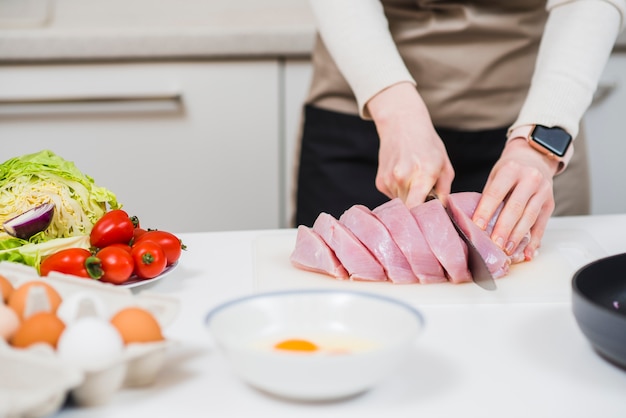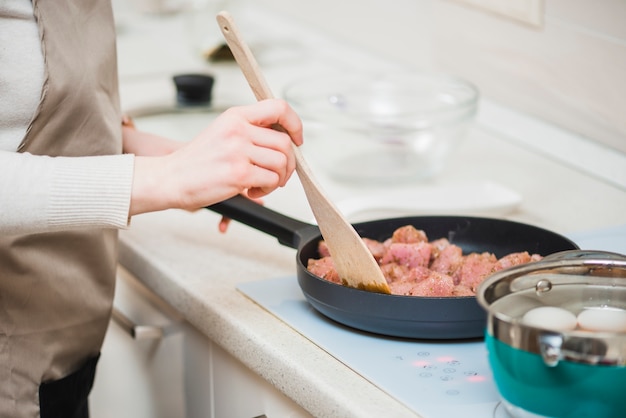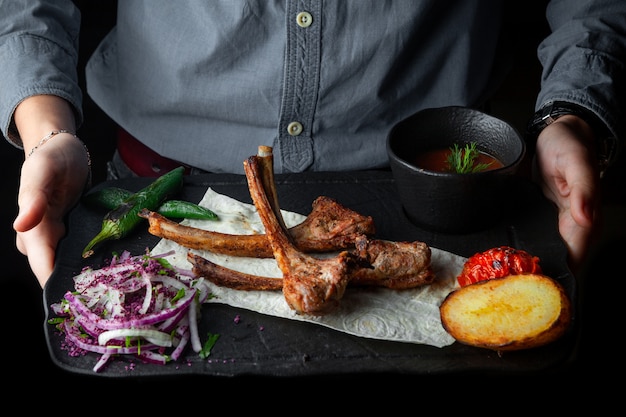As a seasoned cook, I've always been a bit of a food safety enthusiast, and let me tell you, pork used to give me a bit of a fright. The thought of undercooked pork and the potential for food poisoning always made me a little uneasy. But over time, with a bit of research and plenty of practical experience in the kitchen, I've realised that cooking pork is actually quite straightforward – as long as you know the basics, of course. And one of the most important basics is knowing the safe internal temperature for pork. It's not just about avoiding a nasty stomach bug, it's about ensuring your pork is delicious and juicy too.
In this article, we'll be taking a deep dive into the world of pork cooking temperatures, uncovering the science behind safe pork preparation, exploring the different cuts of pork and their ideal temperatures, and sharing some handy tips to make you a pork cooking pro. By the time you've finished reading, you'll feel confident serving up safe and delicious pork dishes for your family and friends.
(Part 1) Understanding the Risks: Why Temperature Matters

I remember back in the day, when pork was considered a bit of a risky business. Before modern food safety practices, the risk of trichinosis, a parasitic infection, was a real concern. That's why Grandma would always tell you to cook your pork “well done” – no pink allowed! Thankfully, those days are behind us. Thanks to improved farming and husbandry practices, the risk of trichinosis is now incredibly low in the UK. This means we can safely enjoy pork cooked to a lower internal temperature, unlocking a whole new world of flavour and tenderness.
The Science Behind Safe Pork Cooking
The reason we cook meat in the first place is to eliminate any harmful bacteria that might be lurking within. The heat breaks down these bacteria, rendering them harmless. Different types of bacteria require different temperatures and durations to be destroyed. For pork, the recommended minimum internal temperature is 145°F (63°C) for at least 15 seconds. This temperature ensures that the most common bacteria found in pork are killed, providing peace of mind and a delicious meal.
What Happens When Pork is Undercooked?
Undercooked pork, particularly when served raw or pink, poses a risk of food poisoning. The most common culprit is Salmonella, a bacteria that can cause a range of unpleasant symptoms, including nausea, vomiting, diarrhoea, and abdominal cramps. While not usually life-threatening for healthy individuals, it can be very uncomfortable and even more dangerous for vulnerable groups like the elderly, pregnant women, and young children. So, it's always best to play it safe and cook your pork thoroughly.
(Part 2) The Magic Number: Safe Internal Temperatures

Now that we understand why safe cooking temperatures are crucial, let's move on to how to achieve them. Knowing the right internal temperature is essential for safe and delicious pork cooking. The good news is, it's a simple concept: use a meat thermometer to check the internal temperature of your pork before serving.
Safe Internal Temperature for Pork: The Basics
The Food Standards Agency (FSA) recommends that all pork, including chops, roasts, and sausages, should be cooked to a minimum internal temperature of 145°F (63°C). This temperature might sound high, but remember, pork doesn't need to be cooked to a dry, rubbery texture. We'll dive into the art of achieving juicy and flavourful pork later on.
Using a Meat Thermometer: Your New Best Friend
A meat thermometer is your best friend in the kitchen, especially when it comes to pork. There's no guesswork or relying on visual cues with a meat thermometer. Simply insert the thermometer into the thickest part of the pork, avoiding any bone, and check the reading. It's that simple! If you're using a digital thermometer, you’ll get an instant reading. If you’re using an analogue thermometer, allow it to sit for a few seconds to get an accurate reading. Once the temperature reaches 145°F (63°C), your pork is safe to eat.
Not All Pork is Created Equal: Different Cuts, Different Temperatures
While the general rule of 145°F (63°C) applies to all cuts of pork, there can be slight variations in cooking temperatures depending on the specific cut and how it's being cooked. For example, if you're grilling a thick pork chop, you might aim for a slightly higher internal temperature to ensure it's cooked through without becoming dry.
Here's a quick guide to the recommended internal temperatures for different cuts of pork:
| Cut of Pork | Recommended Internal Temperature |
|---|---|
| pork chops | 145°F (63°C) |
| pork roast | 145°F (63°C) |
| pork tenderloin | 145°F (63°C) |
| pork sausage | 160°F (71°C) |
Remember, these are just guidelines. If you're ever unsure, it's always best to err on the side of caution and cook your pork to a slightly higher temperature.
(Part 3) Beyond Safety: Mastering the Art of Pork Cooking

Safety is paramount, but we can't forget about flavour! Cooking pork to a safe temperature doesn't mean sacrificing juiciness and tenderness. With a few simple tips and tricks, you can elevate your pork dishes from good to great.
The Importance of Resting: Letting Your Pork Relax
One of the biggest secrets to juicy pork is letting it rest after cooking. When you take pork out of the oven or off the grill, its internal temperature will continue to rise for a few minutes. This process, called carryover cooking, ensures your pork cooks evenly and retains moisture. Allow your pork to rest for at least 10-15 minutes before carving, covering it loosely with foil to keep it warm. This will allow the juices to redistribute throughout the meat, resulting in a succulent and tender final product.
Brining: A Simple Trick for Extra Juiciness
Brining is a technique that involves soaking meat in a salt solution before cooking. The salt draws out moisture from the meat, then reabsorbs it along with the salt, creating a more tender and flavourful end result. Brining is particularly helpful for lean cuts of pork, such as chops and tenderloin. Simply mix a solution of salt and water (about 1/2 cup salt per gallon of water), submerge your pork in the solution for a few hours or overnight, then pat it dry before cooking. You'll be surprised at the difference it makes!
Don’t Overcook! The Fine Line Between Done and Dry
While it's important to cook pork to a safe temperature, it's also crucial not to overcook it. overcooked pork can become dry and tough, making it less enjoyable to eat. Keep a close eye on your pork as it cooks, and use a meat thermometer to check the temperature frequently. Once it reaches 145°F (63°C), remove it from the heat immediately to prevent it from drying out.
(Part 4) Cooking Methods: Finding the Perfect Technique
The way you cook your pork can have a big impact on its texture and flavour. Experiment with different cooking methods to find your favourites.
Roasting: For Tender and Juicy Pork
Roasting is a great option for larger cuts of pork, such as roasts and shoulders. The slow, even heat of the oven allows the fat to render and the meat to become incredibly tender. Season your pork generously with salt, pepper, and any other herbs or spices you like, then roast it in a preheated oven until it reaches an internal temperature of 145°F (63°C). Make sure to baste the pork with pan juices or a glaze during cooking to keep it moist. For a beautiful, crispy crackling, score the skin of your pork roast before cooking and rub it with salt.
Grilling: Bringing Out the Smoky Flavour
Grilling is a fantastic way to add smoky flavour to pork chops and tenderloin. Heat your grill to medium-high heat, then grill the pork for 3-5 minutes per side, or until it reaches an internal temperature of 145°F (63°C). For best results, use a meat thermometer to avoid overcooking. You can also grill whole pork roasts, but they will take longer to cook.
Pan-Frying: Quick and Easy for Smaller Cuts
Pan-frying is a quick and easy way to cook smaller cuts of pork, such as chops and steaks. Heat a heavy-bottomed skillet over medium-high heat, then add a small amount of oil. Season your pork generously with salt and pepper, then cook for 3-5 minutes per side, or until it reaches an internal temperature of 145°F (63°C). You can also add other ingredients to the pan, such as onions, garlic, or peppers, to create a delicious sauce.
Slow-Cooking: Tenderness at its Best
Slow-cooking is a perfect method for tougher cuts of pork, such as shoulder and ribs. The long, slow cooking time breaks down the connective tissues, resulting in incredibly tender and flavorful meat. Simply season your pork with salt, pepper, and any other spices you like, then cook it in your slow cooker on low heat for 6-8 hours, or until it is fall-off-the-bone tender. Slow-cooked pork is perfect for pulled pork sandwiches, tacos, or simply served with a side of mashed potatoes.
(Part 5) pork recipes: Inspiration for Your Next Meal
Now that you've got a solid understanding of the science and technique behind safe and delicious pork cooking, let's get inspired with some delicious recipes.
Classic roast pork with Apple Sauce
This recipe is a true crowd-pleaser. The roast pork is perfectly tender and juicy, while the apple sauce adds a sweet and tangy counterpoint. You can easily adjust the recipe to your own preferences, adding different herbs and spices to the pork rub or using a different fruit for the sauce.
grilled pork chops with Mango Salsa
These juicy grilled pork chops are a perfect summer meal. The mango salsa adds a tropical twist, while the grilled pork offers a smoky flavour. You can use any type of pork chop for this recipe, but bone-in chops are particularly flavorful.
Pan-Seared Pork Tenderloin with Creamy Mushroom Sauce
This dish is elegant and sophisticated, yet surprisingly simple to prepare. The pan-seared pork tenderloin is cooked to perfection, while the creamy mushroom sauce adds a rich and decadent touch. Serve this dish with your favourite vegetables or mashed potatoes for a complete meal.
(Part 6) Storing Pork Safely: From Fridge to Freezer
Just as important as knowing how to cook pork safely is understanding how to store it properly. Storing your pork correctly is crucial for preventing bacterial growth and ensuring food safety.
Refrigerator Storage: Keep It Cold
Fresh pork should be stored in the refrigerator at 40°F (4°C) or below. It is best to store pork on a plate or in a container to prevent juices from dripping onto other foods. Uncooked pork can be safely stored in the refrigerator for 3-5 days. If you're unsure about the freshness of your pork, it's always best to err on the side of caution and discard it.
Freezing Pork for Later
If you want to store your pork for a longer period, you can freeze it. Freeze pork in airtight containers or freezer-safe bags, removing as much air as possible. Frozen pork can be safely stored for 4-6 months. To thaw frozen pork, place it in the refrigerator for 1-2 days. You can also thaw frozen pork in cold water, but make sure to change the water every 30 minutes. Never thaw pork at room temperature, as this can encourage bacterial growth.
(Part 7) Pork and Food Safety: Tips and Tricks
Now that you’ve got the basics down, here are a few more tips to help you ensure food safety when handling and preparing pork:
Wash Your Hands Frequently
Wash your hands thoroughly with soap and warm water for at least 20 seconds before and after handling raw pork. This will help to prevent the spread of bacteria.
Keep Raw Pork Separate
Always keep raw pork separate from other foods, especially cooked food. Use separate cutting boards and utensils for raw pork and cooked food. This will prevent cross-contamination.
Cook Pork Thoroughly
This is the most important food safety tip for pork. Make sure to cook pork to an internal temperature of 145°F (63°C) to kill any harmful bacteria. Use a meat thermometer to check the temperature, as it's not always possible to judge doneness by appearance alone.
Don't Reheat Pork More Than Once
Once cooked pork has been reheated, it's best not to reheat it again. Reheating pork multiple times can increase the risk of bacterial growth.
Trust Your Gut
If you're ever unsure about the freshness or safety of your pork, it's always best to err on the side of caution and discard it. It's not worth the risk of getting food poisoning.
(Part 8) FAQs: Your Pork Cooking Questions Answered
Here are some frequently asked questions about pork cooking, with helpful answers to guide you along the way:
1. What if My Pork Doesn’t Reach the Safe Temperature?
If your pork doesn’t reach the safe internal temperature of 145°F (63°C), it’s best to discard it. It’s not safe to eat undercooked pork, even if it looks cooked on the outside. Food safety should always be your top priority.
2. Can I Use a Thermometer to Check My Pork’s Doneness Before Cooking?
No, it’s not recommended to use a thermometer to check your pork’s doneness before cooking. This can actually puncture the meat and allow bacteria to enter, increasing the risk of food poisoning. Focus on using the thermometer after cooking to ensure it's reached the safe temperature.
3. What if My Pork is Overcooked?
While overcooked pork won’t make you ill, it can be dry and tough. If your pork is overcooked, try to salvage it by shredding it and using it in a recipe like pulled pork sandwiches or tacos.
4. Can I Cook Pork to a Higher Temperature?
You can certainly cook your pork to a higher temperature if you prefer. However, this may result in a drier and tougher texture. If you’re aiming for a juicy and tender pork, stick to the recommended internal temperature of 145°F (63°C). The lower temperature will help to retain moisture and keep the pork tender.
5. Why Does the FSA Recommend a Higher Temperature for Pork Sausage?
Pork sausage is generally made with a higher fat content than other cuts of pork. This fat can shield bacteria from the heat, so a higher internal temperature is recommended to ensure that it’s cooked through and safe to eat.
Conclusion
Cooking pork safely and deliciously is a rewarding experience. By following the tips and techniques outlined in this article, you can confidently prepare mouthwatering pork dishes for your family and friends. Remember, the key is to always check the internal temperature of your pork using a meat thermometer, and never hesitate to err on the side of caution. Enjoy the journey of exploring different pork recipes and uncovering the versatility of this delicious ingredient!
Everyone is watching

Prime Rib Roast Cooking Time Chart: Per Pound Guide
Cooking TipsPrime rib roast. Just the name conjures images of lavish dinners, crackling fires, and hearty laughter. It’s ...

How Long to Bake Potatoes in the Oven (Perfect Every Time)
Cooking TipsBaked potatoes are a staple in my kitchen. They're incredibly versatile, delicious, and surprisingly easy to m...

Perfect Rice Every Time: The Ultimate Guide to Cooking Rice
Cooking TipsAs a self-proclaimed foodie, I've always been a bit obsessed with rice. It's the foundation of countless cuisi...

The Ultimate Guide to Cooking Asparagus: Tips, Techniques, and Recipes
Cooking TipsAsparagus. The mere mention of this spring delicacy conjures up images of vibrant green spears, crisp and burs...

Ultimate Guide to Cooking the Perfect Thanksgiving Turkey
Cooking TipsThanksgiving. Just the word conjures up images of overflowing tables laden with delicious food, the scent of r...
